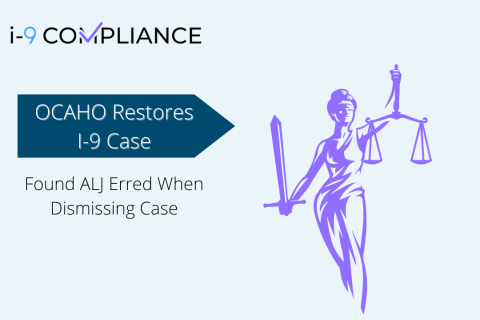CAHO Restores I-9 Case Finding ALJ Erred In Dismissal

The U.S. Department of Justice (DOJ) recently revived a case brought by the U.S. Department of Homeland Security (DHS). This case concerns an employer’s alleged failure to maintain proper Form I-9s for all its employees. According to the Chief Administrative Hearing Officer (CAHO), the court incorrectly dismissed the case. The chief found the mistake stems from procedural issues, not motions by either party.
The underlying issue with this decision began on December 27, 2023. The DHS had filed a complaint with the Office of the Chief Administrative Hearing Officer (OCAHO) against a vehicle services provider. According to the complaint, the provider failed to “prepare and/or present employment eligibility verification forms (‘Forms I-9’) for 19 individuals and [failed] to ensure proper completion of Forms I-9 for six individuals.”
The DHS also submitted the Notice of Intent to Fine previously provided to the employer. However, the paperwork did not include the employer’s request for a hearing regarding the alleged violations. According to the case, both parties filed with the OCAHO. The employer requested a move to dismiss, arguing that no violations had occurred. They also insisted that the statute of limitations barred the claims.
Though the DHS responded to the employer’s argument, neither party addressed the missing request for a hearing attached to the complaint. On April 30, 2024, the Administrative Law Judge (ALJ) overseeing the case issued a sua sponte Order for Dismissal. The ALJ found that the case failed to meet the pertinent regulatory requirements. This finding resulted in a facial deficiency due to the failure to include a copy of the request for a hearing.
However, CAHO James McHenry reversed this decision upon reviewing the case. According to the CAHO, the employer could have used this error as a defense but did not. As such, the ALJ should not have dismissed the case. The CAHO clarified that an ALJ may dismiss complaints that fail to state a claim or abandoned claims. However, this case did not stand on either ground. CAHO McHenry also found that the ALJ did not allow either party a chance to respond before dismissing the case.
These issues have remanded the case for further proceedings. As such, whether the case failed to maintain I-9 compliance will undergo additional review. One way to avoid such litigation is by incorporating an electronic I-9 management system into the onboarding system. This system offers guidance throughout the process, secure digital storage and an optional E-Verify integration.
Learn more about automating your employment eligibility verification and ensuring compliance with I-9Compliance.